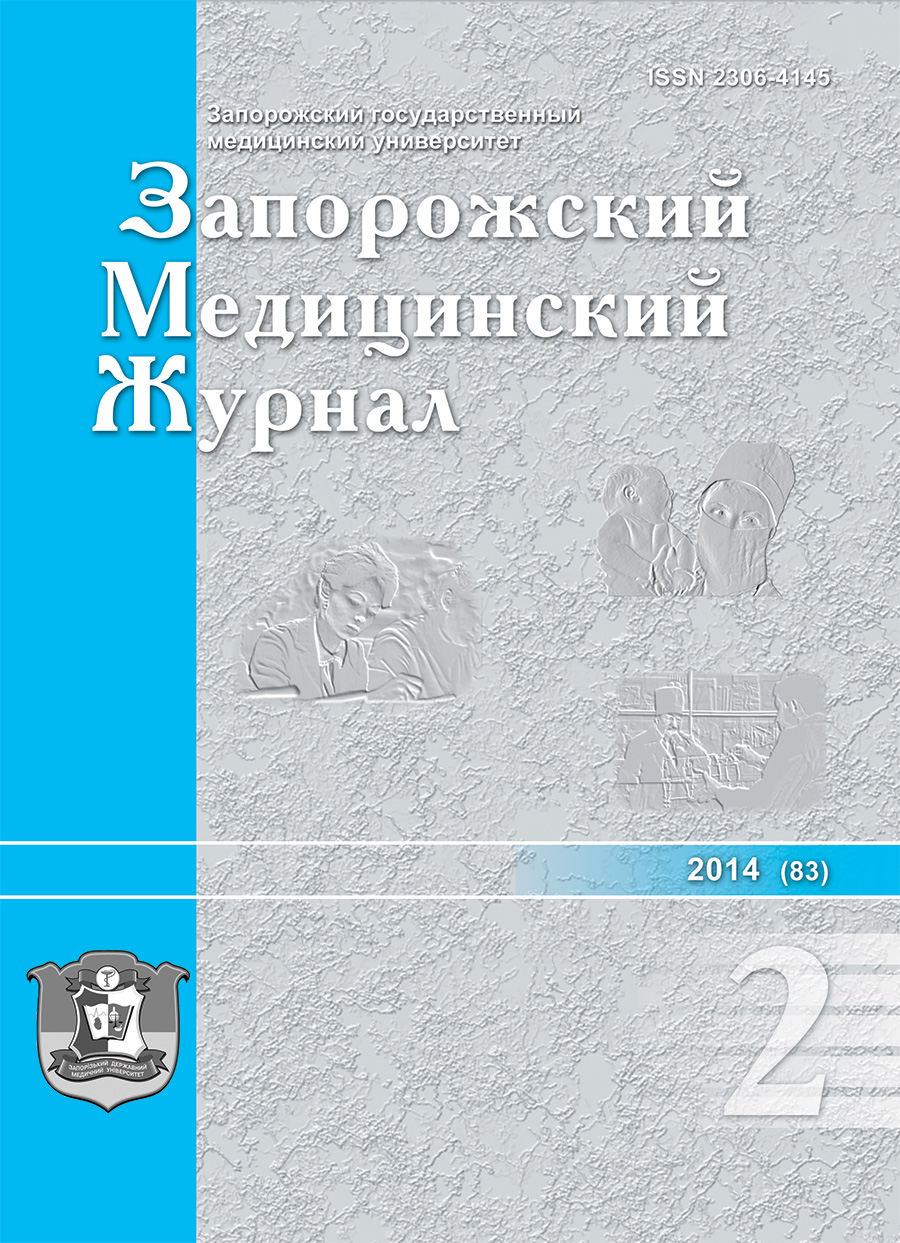Аrterial hypertension in vascular remodelling context: solved and unsolved questions
DOI:
https://doi.org/10.14739/2310-1210.2014.2.25432Keywords:
arterial hypertension, vascular remodelling, arterial stiffness, pulse wave velocity, microcirculationAbstract
The review of the modern literary data concerning features of pathological vascular remodelling in various links of a vascular channel in arterial hypertension is presented. Factors which influence on morpho-functional condition of a vascular wall at the given disease were analyzed. The role of disturbances of elastic properties of arterial vessels and microcirculatory disorders as universal pathogenetic mechanisms of formation, development and progressing of arterial hypertension was accented.
References
Маkolkin V.I., Podzolkov V.I., Branko V.V. Mikrotsirkulatsia v kardiologii [Microcirculation in cardiology]: ed. by V.I.Маkolkin: Мoscow; Vizart 2004: 135p.
Nakaz MOZ Ukrainе № 384 vid 24.05.2012 «Pro zatverdzhennya ta vprovadzhennya mediko-technologichnych dokumentiv zi standartizatsii medichnoy dopomogi pri arterialny gipertensii. – Аvailable at http://moz.gov.ua.
Sirenko Yu.М., Radchenko G.D. Elastic properties of arteries: definition, methods of investigation, value for cardiological practice. Ukr. Kard. Zh. 2008; 6: 32-37.
Lajemi M., Labat C., Gautier S., Lacolley P., Safar M., Asmar R., Cambien F., Benetos A. Angiotensine II type 1 receptor-153 A/G and 1166 A/C gene polymorphisms and increase in aortic stiffness with age in hypertensive subjects. J. Hypertens. 2001; 19: 407-413.
Blacher J., Safar M.E. Large-artery stiffness, hypertension and cardiovascular risk in older patients. Nat. Clin. Pract. Cardiovasc. Med. 2005; 2(9): 450-455.
Cheng C., Daskalakis C., Falkner B. Capillary rarefi cation in treated and untreated hypertensive subjects. J. Ther. Adv. Cardiovasc. Dis. 2008; 2: 79-88.
Laurent S., Cockcroft J., Van Bortel L., et al.: Expert consensus document on arterial stiffness: methodological issues and clinical applications. Eur. Heart. J. 2006; 27: 2588-2605.
Feihl F., Liaudet L., Waeber B. The macrocirculation and microcirculation of hypertension. Current Hypertension Reports 2009; 11(3): 182-189.
Gibbons G.H, Dzau V.J. The emerging concept of vascular remodeling. New Engl. J. Med. 1994; 20: 1431-1438.
Feihl F., Liaudet L., Levy B.I., Waeber B. Hypertension and microvascular remodelling. Cardiovasc. Res. 2008; 78: 274-285.
You D., Cochain C., Loinard C., Vilar J., Mees B., Duriez M., Levy B.I., Silvestre J.S. Hypertension impairs postnatal vasculogenesis: role of antihypertensive agents. Hypertension 2008; 51: 1537-1544.
Debbabi H., Uzan L., Mourad J.J., Levy B.I., Tibiriçá E. Increased skin capillary density in treated essential hypertensive patients. Am. J. Hypertens. 2006; 5: 477-483.
Intengan H.D., Schiffrin E.L.Vascular remodeling in hypertension: roles of apoptosis, inflammation, and fibrosis. Hypertension 2001; 38: 581-587.
Dart A.M., Gatzka C.D., Cameron J.D., Kingwell B.A., Liang Y.L. Large artery stiffness is not related to plasma cholesterol in older subjects with hypertension. Arterioscler. Thromb. Vasc. Biol. 2004; 24: 962-968.
Laurent S., Boutouyrie P., Lacolley P. Structural and genetic bases of arterial stiffness. Hypertension 2005; 45(6): 1050-1055.
Kumaran K., Fall C.H., Martyn C.N., Vijayakumar M., Stein C.E., Shier R. Left ventricular mass and arterial compliance: relation to coronary heart disease and its risk factors in South Indian adults. Int. J. Cardiol. 2002; 83(1): 1-9.
Mayet I., Hughes A. Cardiac and vascular pathophysiology in hypertension. Heart 2003; 89: 1104-1109.
Newby A.C., Zaltsman A.B. Molecular mechanisms in intimal hyperplasia J. Pathol. 2000; 190: 300-309.
Nichols W., O’Rourke M., Vlachopoulos C. McDonald’s Blood flow in arteries. Theoretical, experimental and clinical principles. Edn.6; CRC Press, Hodder Arnold Publication 2011: 768 р.
O’Rourke M.F., Pauca A., Jiang X.J.: Pulse wave analysis. Br. J. Clin. Pharmacol. 2001; 51:507-522.
O’Rourke M.F. Safar M.E. Relationship between aortic stiffening and microvascular disease in brain and kidney: cause and logic of therapy. Hypertension 2005; 46: 200-204.
Antonios T.F.T., Rattray F.M., Singer D.R.J., Markandu D., Mortimer P.S., MacGregoret G.A. Rarefaction of skin capillaries in normotensive offspring of individuals with essential hypertension. Heart 2003; 89: 175-178.
Okura T., Watanabe S., Kurata M., Manabe S., Koresawa M., Irita J., Enomoto D., Miyoshi K., Fukuoka T., Higaki J. Relationship between cardio-ankle vascular index (CAVI) and carotid atherosclerosis in patients with essential hypertension. Hypertens. Res. 2007; 30: 335-340.
Rizzoni D., Palombo C., Porteri E., Muiesan M.L., Kozakova M., La Canna G.: Relationships between coronary flow vasodilator capacity and small artery remodelling in hypertensive patients. J. Hypertens. 2003, 21: 625-631.
Renna N.F., Heras N., Miatello R.M. Pathophysiology of vascular remodeling in hypertension. Int. J. of Hypertension 2013; (2013):7р.: Available at http://dx.doi.org/10.1155/2013/808353,2013.
Safar M.E. Systolic hypertension in the elderly: arterial wall mechanical properties and the renin-angiotensin-aldosterone system. J. Hypertens. 2005; 23: 673-681.
Mathiassen O.N., Buus N.H., Sihm I., Thybo N.K., Mоrn B., Schroeder A.P., Thygesen K., Aalkjaer C., Lederballe O., Mulvany M.J., Christensen K.L. Small artery structure is an independent predictor of cardiovascular events in essential hypertension. J. Hypertens. 2007; 25: 1021-1026.
Struijker Boudier H.A. Arteriolar and capillary remodeling in hypertension. Drugs 1999; 59: 37-40.
Virdis A., Taddei S. How to evaluate microvascular organ damage in hypertension: assessment of endothelial function. High. Blood. Press. Cardiovasc. Prev. 2011; 18(4): 163-167.
Mancia G., Fagard R., Narkiewicz K., et al. 2013 ESH/ESC Guidelines for the management of arterial hypertension. The Task Force for the management of arterial hypertension of the European Society of Hypertension (ESH) and of the European Society of Cardiology (ESC). Eur. Heart J. 2013; 34: 2159-2219.
Downloads
How to Cite
Issue
Section
License
Authors who publish with this journal agree to the following terms:
Authors retain copyright and grant the journal right of first publication with the work simultaneously licensed under a Creative Commons Attribution License that allows others to share the work with an acknowledgement of the work's authorship and initial publication in this journal. 
Authors are able to enter into separate, additional contractual arrangements for the non-exclusive distribution of the journal's published version of the work (e.g., post it to an institutional repository or publish it in a book), with an acknowledgement of its initial publication in this journal.
Authors are permitted and encouraged to post their work online (e.g., in institutional repositories or on their website) prior to and during the submission process, as it can lead to productive exchanges, as well as earlier and greater citation of published work (See The Effect of Open Access)

